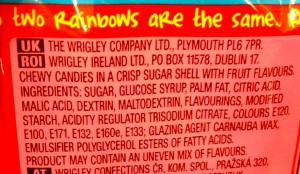Food colouring E – numbers from 100-199
Colours are added to foods to make them look more appealing or more like the colour that consumers associate with that food. ‘We taste with our eyes’ it is said to describe the results of tests that conclude consumers believed something tastes better if it is the expected colour. They are also used to replace the natural colour lost during food processing or storage, to enhance the natural colour or to make products a consistent colour. They are even used to give colour to an item that might otherwise be colourless like the Skittles above. Some groups argue that adding colour is unnecessary and misleading as well as raising concerns over their safety.
The EU laws currently allow 45 colours and also control what foods they are used in and maximum amounts allowed – extremely small amounts in most cases. The EFSA (European Food Safety Authority) tests for safety (and re-evaluates these results) and issues ADI’s (Acceptable Daily Intakes) for each substance, calculating and allowing for a lifetime’s consumption (this includes the usual safety factor margin of 100 for all E numbers).
Colours commonly used:
- Curcumin (E100), a yellow colour extracted from turmeric roots.
- Plain caramel (E150a), which is used in products such as gravy and soft drinks
- Riboflavin (vitamin B2 – E101)
- Beta-carotene (E160a)
- Amaranth (E123)
Colourings for food are either synthetic, created from natural sources or ‘nature identical’. Natural food colourings come from plant sources such as fruit skins, vegetables, grasses and roots. The red colourant carminic acid (E120/cochineal) comes from the dried and crushed bodies of a type of insect.
Manufacturers often prefer synthetic colours as they are stable and consistent, usually brighter than the original, and mostly cheaper to make. It also means a colour, like the above-mentioned carminic acid, can be recreated without the inclusion of the insects! An added advantage is that the synthetic colours need no further processing to be added to foods as they are water soluble as opposed to the oil soluble natural and nature identical colours which need a further processing stage to be useable.
However some colours, especially those called the ‘azo dyes’ are associated by some pressure groups to behavioural problems in children (especially ADHD) and others with skin problems and certain cancers. The UK Food Standards Agency requires a mandatory warning of the presence of six artificial colours (that combined with the preservative sodium benzoate have been linked to increased hyper activity in children), passed a voluntary ban(!) and publish a list of brands that produce items without these colours.
EFSA reduced the ADI of these three of the six most contentious colours too:
- Sunset yellow – E110 – typically found in orange flavoured drinks and cordials, apricot jam, marmalade and packet soups.
- Ponceau 4R – E124 – (banned in the US as a result of its link with cancers). Used in dessert toppings, jellies, trifles, soups and salami.
- Quinoline Yellow – E104 – used to dye smoked haddock (an alarming yellow colour!) and egg products like scotch eggs. But more typically found in lipsticks and some medications
However, it did not reduce these three:
- Carmoisine – E122 – used in jams, yoghurts and jellies.
- Tartrazine – E102 which is the colour most strongly linked to hyperactivity in kids. Tartrazine is actually a yellow dye and can be found in a lot of yellow coloured foods (such as ice cream) and is the base for the creation of many other colours (used as a primary yellow).
- Allura red – E129, typically found in sweets, soft drinks but also in medicines.
However, the research and studies conducted have proved to be inconclusive regarding any links to problems caused by these colours at the amounts allowed…
Regardless, as with any of these additive issues, if you are concerned about the potential harmful effects then it’s best to avoid all foods containing any contentious additives…makes sense, right?
